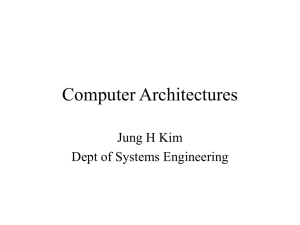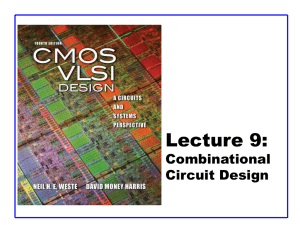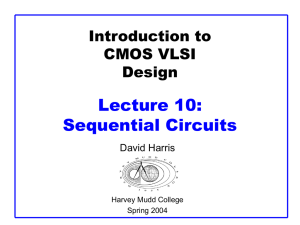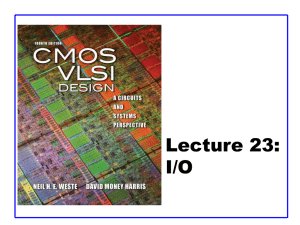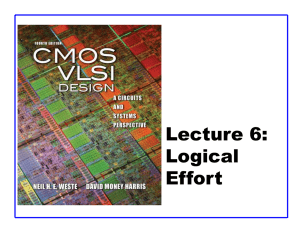Sequential Circuit Design: VLSI Lecture Notes
advertisement
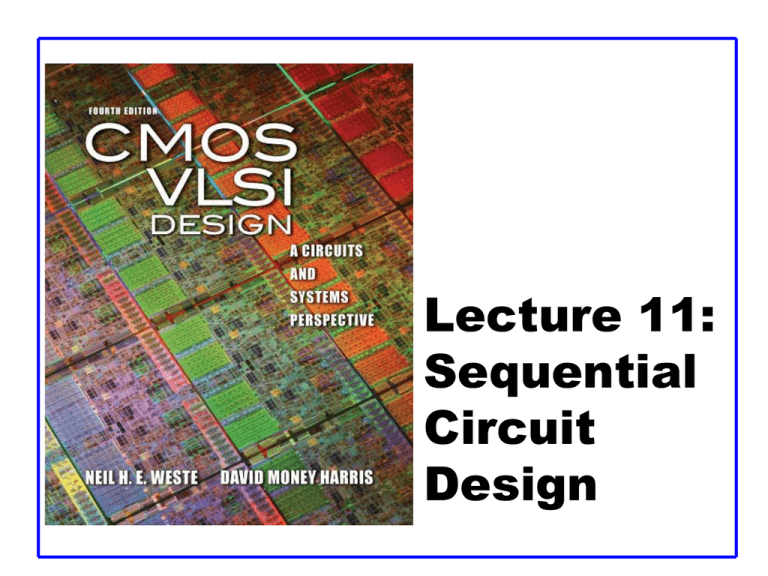
Lecture 11: Sequential Circuit Design Outline Sequencing Sequencing Element Design Max and Min-Delay Clock Skew Time Borrowing Two-Phase Clocking 11: Sequential Circuits CMOS VLSI Design 4th Ed. 2 Sequential Logic 11: Sequential Circuits CMOS VLSI Design 4th Ed. 3 Sequencing Combinational logic – output depends on current inputs Sequential logic – output depends on current and previous inputs – Requires separating previous, current, future – Called state or tokens – Ex: FSM, pipeline clk in clk clk clk out CL Finite State Machine 11: Sequential Circuits CL CL Pipeline CMOS VLSI Design 4th Ed. 4 Sequencing Cont. If tokens moved through pipeline at constant speed, no sequencing elements would be necessary Ex: fiber-optic cable – Light pulses (tokens) are sent down cable – Next pulse sent before first reaches end of cable – No need for hardware to separate pulses – But dispersion sets min time between pulses This is called wave pipelining in circuits In most circuits, dispersion is high – Delay fast tokens so they don’t catch slow ones. 11: Sequential Circuits CMOS VLSI Design 4th Ed. 5 Sequencing Overhead Use flip-flops to delay fast tokens so they move through exactly one stage each cycle. Inevitably adds some delay to the slow tokens Makes circuit slower than just the logic delay – Called sequencing overhead Some people call this clocking overhead – But it applies to asynchronous circuits too – Inevitable side effect of maintaining sequence 11: Sequential Circuits CMOS VLSI Design 4th Ed. 6 Sequencing Elements Flop Latch Latch: Level sensitive – a.k.a. transparent latch, D latch Flip-flop (or Register): edge triggered – A.k.a. master-slave flip-flop, D flip-flop, D register Timing Diagrams clk clk – Transparent D Q D Q – Opaque – Edge-trigger clk D Q (latch) Q (flop) 11: Sequential Circuits CMOS VLSI Design 4th Ed. 7 Latch versus Register Latch stores data when clock is low Register stores data when clock rises D Q D Q Clk Clk Clk Clk D D Q Q CMOS VLSI Design 4th Ed. Latches 11: Sequential Circuits CMOS VLSI Design 4th Ed. 9 Timing Definitions CLK t tsu D D thold DATA STABLE Q CLK t tc 2 Q Register q DATA STABLE CMOS VLSI Design 4th Ed. t Characterizing Timing 11: Sequential Circuits CMOS VLSI Design 4th Ed. 11 Latch Design Pass Transistor Latch Pros + Tiny + Low clock load Cons – Vt drop – nonrestoring – backdriving – output noise sensitivity – dynamic – diffusion input 11: Sequential Circuits CMOS VLSI Design 4th Ed. D Q Used in 1970’s 12 Latch Design Transmission gate + No Vt drop - Requires inverted clock D Q 11: Sequential Circuits CMOS VLSI Design 4th Ed. 13 Latch Design Inverting buffer + Restoring + No backdriving + Fixes either • Output noise sensitivity • Or diffusion input – Inverted output 11: Sequential Circuits CMOS VLSI Design 4th Ed. X D Q D Q 14 Latch Design Tristate feedback + Static – Backdriving risk X D Static latches are now essential because of leakage 11: Sequential Circuits CMOS VLSI Design 4th Ed. Q 15 Latch Design Buffered input + Fixes diffusion input + Noninverting X D Q 11: Sequential Circuits CMOS VLSI Design 4th Ed. 16 Latch Design Buffered output + No backdriving X D Widely used in standard cells + Very robust (most important) - Rather large - Rather slow (1.5 – 2 FO4 delays) - High clock loading 11: Sequential Circuits CMOS VLSI Design 4th Ed. Q 17 Latch Design Datapath latch + smaller + faster - unbuffered input Q X D 11: Sequential Circuits CMOS VLSI Design 4th Ed. 18 Flip-Flop Design Flip-flop is built as pair of back-to-back latches X D Q X D Q 11: Sequential Circuits Q CMOS VLSI Design 4th Ed. 19 Enable Enable: ignore clock when en = 0 – Mux: increase latch D-Q delay – Clock Gating: increase en setup time, skew Symbol Multiplexer Design Clock Gating Design en D 1 Q 0 en Q D en 1 0 Q Q D en Flop D Flop Flop Q en D Latch Latch D Latch Q en 11: Sequential Circuits CMOS VLSI Design 4th Ed. 20 Reset Force output low when reset asserted Synchronous vs. asynchronous Q D reset Synchronous Reset Q reset D Q Q Asynchronous Reset Q Q reset reset D D reset reset 11: Sequential Circuits Q reset reset D Flop Symbol D Latch CMOS VLSI Design 4th Ed. 21 Set / Reset Set forces output high when enabled Flip-flop with asynchronous set and reset reset set D Q set reset 11: Sequential Circuits CMOS VLSI Design 4th Ed. 22 Sequencing Methods clk clk Combinational Logic tnonoverlap Combinational Logic 1 Combinational Logic Latch 2 Latch 1 Half-Cycle 1 tpw CMOS VLSI Design 4th Ed. p Combinational Logic Latch p Latch Pulsed Latches p tnonoverlap Tc/2 2 Latch 2-Phase Transparent Latches 1 Half-Cycle 1 11: Sequential Circuits Flop clk Flop Flip-Flops Flip-flops 2-Phase Latches Pulsed Latches Tc 23 Timing Diagrams Contamination and Propagation Delays A A tpd Logic Prop. Delay tcd Logic Cont. Delay tpcq Latch/Flop Clk->Q Prop. Delay tccq Latch/Flop Clk->Q Cont. Delay tpdq Latch D->Q Prop. Delay tcdq Latch D->Q Cont. Delay tsetup Latch/Flop Setup Time thold Combinational Logic Y Y clk Flop clk D Q tcd tsetup thold D tpcq Q Latch D tccq clk clk tccq Q Latch/Flop Hold Time 11: Sequential Circuits tpd tsetup tpcq D tcdq thold tpdq Q CMOS VLSI Design 4th Ed. 24 Max-Delay: Flip-Flops sequencing overhead clk Q1 Combinational Logic D2 F2 clk F1 t pd T c t setup t pcq Tc clk Q1 tsetup tpcq tpd D2 11: Sequential Circuits CMOS VLSI Design 4th Ed. 25 Max Delay: 2-Phase Latches D1 sequencing overhead Q1 Combinational Logic 1 D2 1 Q2 Combinational Logic 2 D3 L3 pdq 2 L2 2t L1 t pd t pd 1 t pd 2 T c 1 Q3 1 2 Tc D1 Q1 tpdq1 tpd1 D2 tpdq2 Q2 tpd2 D3 11: Sequential Circuits CMOS VLSI Design 4th Ed. 26 Max Delay: Pulsed Latches D1 p Q1 D2 Combinational Logic L2 p L1 t pd T c m ax t pdq , t pcq t setup t pw Q2 sequencing overhead Tc D1 (a) tpw > tsetup tpdq Q1 tpd D2 p tpcq Q1 Tc tpd tpw tsetup (b) tpw < tsetup D2 11: Sequential Circuits CMOS VLSI Design 4th Ed. 27 Min-Delay: Flip-Flops clk F1 t cd t hold t ccq Q1 CL clk F2 D2 clk Q1 tccq D2 11: Sequential Circuits tcd thold CMOS VLSI Design 4th Ed. 28 Min-Delay: 2-Phase Latches 1 L1 t cd 1, t cd 2 t hold t ccq t nonoverlap 1 L2 D2 Paradox: hold applies twice each cycle, vs. only once for flops. tnonoverlap tccq 2 Q1 D2 11: Sequential Circuits CL 2 Hold time reduced by nonoverlap But a flop is made of two latches! Q1 tcd thold CMOS VLSI Design 4th Ed. 29 Min-Delay: Pulsed Latches p Q1 CL p D2 p L2 Hold time increased by pulse width L1 t cd t hold t ccq t pw tpw thold Q1 tccq tcd D2 11: Sequential Circuits CMOS VLSI Design 4th Ed. 30 Itanium 2 ALU 11: Sequential Circuits CMOS VLSI Design 4th Ed. 31 Combinational Logic Delays Element Propagation Delay Contamination Delay Adder 590 ps 100 ps Result Mux 60 ps 35 ps Early Bypass Mux 110 ps 95 ps Middle Bypass Mux 80 ps 55 ps Late Bypass Mux 70 ps 45 ps 2 mm Wire 100 ps 65 ps 11: Sequential Circuits CMOS VLSI Design 4th Ed. 32 Time Borrowing In a flop-based system: – Data launches on one rising edge – Must setup before next rising edge – If it arrives late, system fails – If it arrives early, time is wasted – Flops have hard edges In a latch-based system – Data can pass through latch while transparent – Long cycle of logic can borrow time into next – As long as each loop completes in one cycle 11: Sequential Circuits CMOS VLSI Design 4th Ed. 33 Time Borrowing Example 1 2 Combinational Logic Borrowing time across half-cycle boundary Combinational Logic Borrowing time across pipeline stage boundary 2 Combinational Logic Latch (b) Latch 1 1 Latch 2 Latch (a) Latch 1 Combinational Logic Loops may borrow time internally but must complete within the cycle 11: Sequential Circuits CMOS VLSI Design 4th Ed. 34 How Much Borrowing? 2 t setup t nonoverlap D1 L1 t borrow Tc 1 2 Q1 Combinational Logic 1 D2 L2 2-Phase Latches Q2 1 Pulsed Latches 2 t borrow t pw t setup tnonoverlap Tc Tc/2 Nominal Half-Cycle 1 Delay tborrow tsetup D2 11: Sequential Circuits CMOS VLSI Design 4th Ed. 35 Clock Skew We have assumed zero clock skew Clocks really have uncertainty in arrival time – Decreases maximum propagation delay – Increases minimum contamination delay – Decreases time borrowing 11: Sequential Circuits CMOS VLSI Design 4th Ed. 36 Skew: Flip-Flops sequencing overhead Q1 F1 t pd T c t pcq t setup t skew clk Combinational Logic D2 F2 clk Tc clk tpcq t cd t hold t ccq t skew Q1 tskew tpdq tsetup D2 F1 clk Q1 CL D2 F2 clk tskew clk thold Q1 tccq D2 11: Sequential Circuits tcd CMOS VLSI Design 4th Ed. 37 Skew: Latches 2t 2 c D2 Q2 Combinational Logic 2 D3 Q3 2 t setup t nonoverlap t skew Pulsed Latches t T m ax t , t pd Combinational Logic 1 1 t cd 1 , t cd 2 t hold t ccq t nonoverlap t skew Tc Q1 1 pdq sequencing overhead t borrow 2 L3 D1 L1 t pd T c 1 L2 2-Phase Latches pdq pcq t setup t pw t skew sequencing overhead t cd t hold t pw t ccq t skew t borrow t pw t setup t skew 11: Sequential Circuits CMOS VLSI Design 4th Ed. 38 Two-Phase Clocking If setup times are violated, reduce clock speed If hold times are violated, chip fails at any speed In this class, working chips are most important – No tools to analyze clock skew An easy way to guarantee hold times is to use 2phase latches with big nonoverlap times Call these clocks 1, 2 (ph1, ph2) 11: Sequential Circuits CMOS VLSI Design 4th Ed. 39 Safe Flip-Flop Past years used flip-flop with nonoverlapping clocks – Slow – nonoverlap adds to setup time – But no hold times In industry, use a better timing analyzer – Add buffers to slow signals if hold time is at risk X D Q 11: Sequential Circuits Q CMOS VLSI Design 4th Ed. 40 Adaptive Sequencing p X Designers include timing margin ERR – Voltage D Q – Temperature – Process variation D Q – Data dependency X – Tool inaccuracies ERR Alternative: run faster and check for near failures – Idea introduced as “Razor” • Increase frequency until at the verge of error • Can reduce cycle time by ~30% p 11: Sequential Circuits CMOS VLSI Design 4th Ed. 41 Conventional CMOS Latches 11: Sequential Circuits CMOS VLSI Design 4th Ed. 42 More CMOS Latches 11: Sequential Circuits CMOS VLSI Design 4th Ed. 43 Clocked CMOS Latches Sometimes called C2MOS Actually, similar to (d) in that it is tristate 11: Sequential Circuits CMOS VLSI Design 4th Ed. 44 Conventional CMOS Flip-Flops 11: Sequential Circuits CMOS VLSI Design 4th Ed. 45 CMOS Flip-Flops This design has a potential race condition. Is more likely if there is skew between the two phases of the clock. One alternative is NORA (NO Race) flip-flop. The other alternative is to use non-overlapping clocks. 11: Sequential Circuits CMOS VLSI Design 4th Ed. 46 NORA Flip-flops 11: Sequential Circuits CMOS VLSI Design 4th Ed. 47 NORA Flip-flops 11: Sequential Circuits CMOS VLSI Design 4th Ed. 48 Pulse Generators 11: Sequential Circuits CMOS VLSI Design 4th Ed. 49 Pulsed Latches The Naffziger pulsed latch is used in Itanium 2 processors. It consists of the latch from (k) and the generator from (b). The pulse width is 1/6 the clock cycle. The pulse generator of (d) is used in the NEC RISC processor. Note that pulses are very fast and have to be distributed in the latch. The Partovi pulsed latch (used on the AMD K6 and Athlon) builds the pulse generator into the latch. 11: Sequential Circuits CMOS VLSI Design 4th Ed. 50 Pulsed Latches 11: Sequential Circuits CMOS VLSI Design 4th Ed. 51 Resettable Latches and Flip-flops There are two types of reset: – Asynchronous – Synchronous Settable latches and flip-flops force the output high rather than low. 11: Sequential Circuits CMOS VLSI Design 4th Ed. 52 Resettable Latches and Flip-flops 11: Sequential Circuits CMOS VLSI Design 4th Ed. 53 Asynchronous Set and Reset 11: Sequential Circuits CMOS VLSI Design 4th Ed. 54 Enabled Latches and Flip-flops 11: Sequential Circuits CMOS VLSI Design 4th Ed. 55 Logic in Latches The sequencing overhead can be reduced by incorporating logic into latches. The DEC Alpha 21164 used a whole assortment of such latches. 11: Sequential Circuits CMOS VLSI Design 4th Ed. 56 Klass Semidynamic FF (SDFF) A cross between pulsed latch and a flip-flop. Used in Sun UltraSparc III along with built in logic. 11: Sequential Circuits CMOS VLSI Design 4th Ed. 57 SDFF Similar to the Partovi pulsed latch. However, it uses a dynamic NAND gate. Faster than the Partovi pulsed latch. Worse skew tolerance and time borrowing capability. 11: Sequential Circuits CMOS VLSI Design 4th Ed. 58 Differential Flip-flops 11: Sequential Circuits CMOS VLSI Design 4th Ed. 59 Differential Flip-flops The design in (a) was used in the Alpha 21164. The SR latch formed by the NAND gates is just a salve and can be replaced by inverters if necessary. The StrongArm 110 processor adds the weak nMOS transistor to reduce the risk when the inputs switch while the clock is high. The AMD K6 uses the design in (b) at the interface between static and domino logic. 11: Sequential Circuits CMOS VLSI Design 4th Ed. 60 Dual Edge Triggered FFs DET flip flops have a similar thoroughput at half the clock frequency. 11: Sequential Circuits CMOS VLSI Design 4th Ed. 61 DET FFs Zhao implicitly pulsed DET FF. 11: Sequential Circuits CMOS VLSI Design 4th Ed. 62 Radiation Hardened FFs 11: Sequential Circuits CMOS VLSI Design 4th Ed. 63 Some Design Guides Dynamic latches and registers have been avoided since the 0.35 mm technology node. – Use static latches and register. Include provisions for testing – We will study these later. Clock distribution, especially multiple phases are problematic. – We will study later. Unless required performance is at the cutting edge, use registers. 11: Sequential Circuits CMOS VLSI Design 4th Ed. 64 Some Design Guides Pulsed latches are best in terms of performance. – Remember that they have long hold times. Extra circuitry may be necessary for short logic paths. 11: Sequential Circuits CMOS VLSI Design 4th Ed. 65 Characterizing Delays 11: Sequential Circuits CMOS VLSI Design 4th Ed. 66 Characterizing Delays The set-up time cannot be crisply defined. If the data changes slightly less than a set-up time before the clock edge, the register will still capture the correct value, but its clock-Q delay will be high. Note that t DQ t DC t CQ tDQ has a minimum when the slope of tCQ is -1. tsetup is defined as the tDC at this point. The propagation delay is the tCQ at this point. The contamination delay tccq is the minimum tCQ that occurs when the input arrives early. The hold time is the minimum delay from clock to D 11: Sequential Circuits CMOS VLSI Design 4th Ed. 67 Characterizing Delays 11: Sequential Circuits CMOS VLSI Design 4th Ed. 68 Characterizing Delays The aperture width, ta is the width of the window around the clock edge during which the data must not transition if the register is to produce the correct output with a propagation delay less than tpcq. t ar t setup 1 t hold 0 t af t setup 0 t hold 1 11: Sequential Circuits CMOS VLSI Design 4th Ed. 69 Characterizing Delays 11: Sequential Circuits CMOS VLSI Design 4th Ed. 70 Characterizing Delays If the data arrives before the clock rises (tDCr > 0), it must wait for the clock. In this region, tCrQ is nearly constant and tDQ increases as the data arrives earlier. If the data arrives after the clock rises, tDQ is essentially independent of arrival time. The data must set up before the falling edge of the clock. If the data arrives too close to the falling edge, tDQ increases. 11: Sequential Circuits CMOS VLSI Design 4th Ed. 71 Characterizing Delays Choose the setup time before the knee of the curve, for example 5% greater than its minimum value. Pulsed latches have different definitions, but they can be converter to ordinary latches by adding or subtracting pulse widths. t setup virtual t setup t pw t pcq virtual t pdq t pw t setup t pdq virtual t setup virtual t pcq virtual t pdq t hold virtual t hold t pw 11: Sequential Circuits CMOS VLSI Design 4th Ed. 72 Delay Trade-offs 11: Sequential Circuits CMOS VLSI Design 4th Ed. 73 State Retention Registers 11: Sequential Circuits CMOS VLSI Design 4th Ed. 74 Level Conversion 11: Sequential Circuits CMOS VLSI Design 4th Ed. 75 Design Margins Designers derate their circuits by about 30% to cope with variations. Adaptive sequential elements seek to reduce this margin. Dynamic voltage scaling – Precharacterize the circuit – Canary circuit – Double sampling the input 11: Sequential Circuits CMOS VLSI Design 4th Ed. 76 Adaptive Sequencing 11: Sequential Circuits CMOS VLSI Design 4th Ed. 77 Adaptive Sequencing (a) shows the conceptual diagram of a razor flip-flop, while (b) is the timing diagram. The razor flip-flop has the drawback that it may become metastable if D changes during the aperture. An improvement is double sampling with time borrowing (DSTB). (d) shows the Razor II pulsed latch. 11: Sequential Circuits CMOS VLSI Design 4th Ed. 78 Synchronizers A synchronizer is a circuit that accepts an input that can change at arbitrary times and produces an output aligned to its clock. This is impossible to do in a finite time. 11: Sequential Circuits CMOS VLSI Design 4th Ed. 79 Metastability 11: Sequential Circuits CMOS VLSI Design 4th Ed. 80 Metastability 11: Sequential Circuits CMOS VLSI Design 4th Ed. 81 Metastability 11: Sequential Circuits CMOS VLSI Design 4th Ed. 82 Metastability The cross-coupled inverters behave like an amplifier with gain G when A is near the metastable voltage Vm. The delay can be modeled with an RC network. Let the initial voltage be A and a small offset from the metastable point be a(0). A 0 V m a 0 Ga t a t C R a t a 0 e s 11: Sequential Circuits t da t dt s RC G 1 CMOS VLSI Design 4th Ed. 83 Metastability Assume that the node reaches a legal logic level when a t V The time to reach this level is t DQ s ln V ln a 0 Note that the speed is given by the RC time constant. GBW is required. High T0 t s P t DQ t e Tc 11: Sequential Circuits CMOS VLSI Design 4th Ed. 84 Synchronizers 11: Sequential Circuits CMOS VLSI Design 4th Ed. 85 Synchronizers 11: Sequential Circuits CMOS VLSI Design 4th Ed. 86 Synchronizers The probability of a synchronizer failure is P failure N T0 Tc T c t setup s e The mean time between failures is T c t setup MTBF 1 P failure Tc e s NT 0 11: Sequential Circuits CMOS VLSI Design 4th Ed. 87 Degrees of Synchrony Classification Periodic f Description Synchronous Yes 0 0 Signal has same frequency and phase as clock. Example: register to register on chip. Mesosynchronous Yes Constant 0 Signal has same frequency, but is out of phase with clock. Safe to sample by delaying. Example: chip tp chip where both chips are using the same clock. Plesiosynchronous Yes Varies slowly Small Signal has nearly the same frequency. Phase drifts slowly with time. Safe to sample signal if it is delayed by a variable, but predictable amount. Example: Board to board with same frequency but different crystals. Periodic Yes Varies rapidly Large Signal is periodic at arbitrary frequency. Board to board with different crystals. Asynchronous No Unknown Unknown Signal changes arbitrarily. 11: Sequential Circuits CMOS VLSI Design 4th Ed. 88 Asynchronous Domains 11: Sequential Circuits CMOS VLSI Design 4th Ed. 89 Asynchronous Domains 11: Sequential Circuits CMOS VLSI Design 4th Ed. 90 Two-Phase Handshake 11: Sequential Circuits CMOS VLSI Design 4th Ed. 91 Arbiters An arbiter decides which of the two inputs came first. 11: Sequential Circuits CMOS VLSI Design 4th Ed. 92 Pipelining 11: Sequential Circuits CMOS VLSI Design 4th Ed. 93 Wave Pipelining 11: Sequential Circuits CMOS VLSI Design 4th Ed. 94 Schmitt Triggers 11: Sequential Circuits CMOS VLSI Design 4th Ed. 95 Noise Suppression 11: Sequential Circuits CMOS VLSI Design 4th Ed. 96 CMOS Schmitt Trigger 11: Sequential Circuits CMOS VLSI Design 4th Ed. 97 Schmitt Trigger Simulated VTC 2.5 2.5 2.0 2.0 VM1 1.5 (V) 1.0 X V 1.5 (V) 1.0 x V VM2 0.5 0.0 0.0 k=1 k=3 k=2 0.5 0.5 1.0 1.5 Vin (V) 2.0 2.5 Voltage-transfer characteristics with hysteresis. k=4 0.0 0.0 0.5 1.0 1.5 2.0 2.5 Vin (V) The effect of varying the ratio of the PMOS device M4. The width is k* 0.5 m. m CMOS VLSI Design 4th Ed. CMOS Schmitt Trigger 2 11: Sequential Circuits CMOS VLSI Design 4th Ed. 99 Multivibrator Circuits R S B is ta b le M u ltiv ib ra to r flip -flo p , S ch m itt T rig g e r T M o n o s ta b le M u ltiv ib ra to r o n e -sh o t A s ta b le M u ltiv ib ra to r o scilla to r CMOS VLSI Design 4th Ed. Transition-Triggered Monostable In DELAY Out td td CMOS VLSI Design 4th Ed. Monostable Trigger (RC-based) VD D R In A B O ut (a ) T r ig ge r c ir cu it. C In B VM Out (b) W av efo r m s. t t1 t2 CMOS VLSI Design 4th Ed. Astable Multivibrators (Oscillators) 11: Sequential Circuits CMOS VLSI Design 4th Ed. 103 Relaxation Oscillator O u t1 O u t2 I2 I1 R C In t T = 2 (log3) R C CMOS VLSI Design 4th Ed. Voltage Controller Oscillator (VCO) VDD VD D M6 M4 S chm itt T rigger restores signal slopes M2 In M1 Ir e f V c on tr Ir e f M3 M5 C u rren t s tarved inve rter t p H L ( ns ec ) 6 4 2 0.0 0.5 1.5 2.5 propagation delay as a function of control voltage V c o n t r (V ) CMOS VLSI Design 4th Ed. Differential Delay Element and VCO in 2 Vo 2 v3 V o1 v1 in 1 v2 Vctrl v 4 two stage VCO 3.0 delay cell 2.5 V1 V 2 V 3 V4 2.0 1.5 1.0 0.5 0.0 2 0.5 0.5 1.5 2.5 3.5 time (ns) simulated waveforms of 2-stage VCO CMOS VLSI Design 4th Ed. Pitfalls and Fallacies Incompletely reporting flip-flop delay. Failing to check hold times. Choosing a sequencing method too late in the design. Failing to synchronize asynchronous inputs. Building faulty synchronizers. 11: Sequential Circuits CMOS VLSI Design 4th Ed. 107 Summary Flip-Flops: – Very easy to use, supported by all tools 2-Phase Transparent Latches: – Lots of skew tolerance and time borrowing Pulsed Latches: – Fast, some skew tol & borrow, hold time risk 11: Sequential Circuits CMOS VLSI Design 4th Ed. 108


